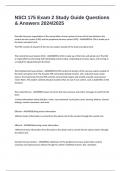NSCI 175 Exam 2 Study Guide Questions
& Answers 2024/2025
Describe the gross organization of the mammalian nervous system in terms of the two divisions: the
central nervous system (CNS) and the peripheral nervous system (PNS) - ANSWERSThe CNS is made up of
the brain and spinal cord.
The PNS consists of all parts of the nervous system outside of the brain and spinal cord.
The Central Nervous System (CNS) - ANSWERSThe CNS is made up of the brain and spinal cord. The CNS
is responsible for processing and interpreting sensory input, responding to sensory input, and serving as
a conduit for signals between the brain.
The Peripheral Nervous System - ANSWERSThe PNS consists of all parts of the nervous system outside of
the brain and spinal cord. The Somatic PNS commands skeletal muscles, skin, and joints (uses motor
axons). The Autonomic/Visceral PNS controls viscera (body organs and smooth muscle) using visceral
motor fibers. This system controls physical reactions that are out of our control, such as butterflies in the
stomach.
The Cranial Nerves - ANSWERS12 pairs of nerves that carry sensory and motor messages to and from the
brain
-Convey information about olfaction, vision, eye movement, touch/pain, taste, hearing, balance, visceral
feelings, muscle movement, and more
Efferent - ANSWERSExiting motor information
-Efferent motor information is carried from the spinal cord to the muscles through the ventral root
Afferent - ANSWERSIncoming motor information
-Afferent sensory information from the body to the spinal cord is carried into the spinal column through
the dorsal root
Somatic Nervous System - ANSWERSA subdivision of the peripheral nervous system that controls
conscious and subconscious actions through its control of skeletal muscles, skin, and joints
,-The body's somatic motor neurons (somas in ventral spinal cord of CNS, axons in PNS) command muscle
contraction
-The cell bodies of somatosensory neurons (which collect info from skin, muscles, and joints) lie in the
dorsal root ganglia
-Signals originate from upper motor neurons in the primary motor cortex
Autonomic/ Visceral Nervous System - ANSWERSThe branch of the nervous system that deals with
unconsciously controlled actions; further broken down into Parasympathetic and Sympathetic
-Innervates internal organs, blood vessels, and glands
-Contract and relax smooth muscles using visceral muscle fibers
-Manages bodily responses that our "our of our control" such as blushing and butterflies in the stomach
-Signals originate from the visceral motor nuclei in the hypothalamus
Dorsal vs Ventral Roots - ANSWERSDorsal roots carry sensory information to the spinal cord from the
body and carry afferent sensory signals while the ventral roots carry motor information from the spinal
cord to the body and carry efferent signals
The Sympathetic Nervous System - ANSWERSThe division of the autonomic nervous system that arouses
the body, mobilizing its energy in stressful situations
-Increased heart rate and blood pressure
-Increased glucose production
-Decreased salivation and digestion
-Controls fight/flight response
-Norepinephrine is released from the adrenal glands
**** Everything speeds up/activity increases ****
Parasympathetic Nervous System - ANSWERSThe division of the autonomic nervous system that calms
the body, conserving its energy
-Slows heart rate
-Stimulates digestion
-Constricts airways
, -Stimulates salivation and digestion
-Acetylcholine is the primary neurotransmitter
**** Slows everything down/activity decreases ****
Sketch a Brain - ANSWERSLabel the cerebrum, cerebellum, lobes, brain stem, thalamus, ventricles, spinal
cord
Cerebrum - ANSWERSWrinkly/folded area of the brain responsible for sensation, perception, cognition,
and motor control
Cerebellum - ANSWERSThe "little brain" at the rear of the brainstem; functions include processing
sensory input and coordinating movement output and balance
-movement control center
Temporal Lobe - ANSWERSHearing, learning, memory
-Sides of the brain near ears
Frontal Lobe - ANSWERSThe portion of the cerebral cortex lying just behind the forehead. Involved in
decision making, motor movements, language, executive functioning, attention, memory, impulsivity,
planning/strategizing, and inhibition to obtain goals
-Seen as what makes humans unique
-Very high number of neurons
Parietal Lobe - ANSWERSPortion of the cerebral cortex lying at the top of the head and toward the rear.
Contains the primary somatic sensory areas, visual processing, and language processing
Occipital Lobe - ANSWERSRegion of the cerebral cortex at the back of the head that manages sight
-Primary visual cortex
Insular Lobe - ANSWERSThe lobe tucked away in the lateral sulcus (inside, side of the brain) that serves
as the gustatory cortex, controls emotion, empathy, compassion, and psychopathology




